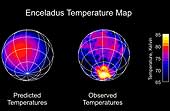|
COMETS EARTH JUPITER KUIPER BELT MARS MERCURY METEORITES NEPTUNE OORT CLOUD PLUTO SATURN SOLAR SYSTEM SPACE SUN URANUS VENUS ORDER PRINTS
PHOTO CATEGORIES SCIENCEVIEWS AMERICAN INDIAN AMPHIBIANS BIRDS BUGS FINE ART FOSSILS THE ISLANDS HISTORICAL PHOTOS MAMMALS OTHER PARKS PLANTS RELIGIOUS REPTILES SCIENCEVIEWS PRINTS
|
Related Documents
Download Options
This image shows the surprise that startled Cassini scientists on the composite infrared spectrometer team when they got their first look at the infrared (heat) radiation from the south pole of Saturn's moon Enceladus. There is a dramatic warm spot centered on the pole that is probably a sign of internal heat leaking out of the icy moon. The data were taken during the spacecraft's third flyby of this intriguing moon on July 14, 2005. Based on data from previous flybys, which did not show the south pole well, team members expected that the south pole would be very cold, as shown in the left panel. Enceladus is one of the coldest places in the Saturn system because its extremely bright surface reflects 80 percent of the sunlight that hits it, so only 20 percent is available to heat the surface. As on Earth, the poles should be even colder than the equator because the sun shines at such an oblique angle there. The right hand panel shows a global temperature image made from measurements of Enceladus' heat radiation at wavelengths between 9 and 16.5 microns. Cassini made the observation from a distance of 84,000 kilometers (52,000 miles) on the approach to Enceladus, and the image shows details as small as 25 kilometers (16 miles). Equatorial temperatures are much as expected, topping out at about 80 degrees Kelvin (-315 degrees Fahrenheit), but the south pole is occupied by a well-defined warm region reaching 85 Kelvin (-305 degrees Fahrenheit). That is 15 degrees Kelvin (27 degrees Fahrenheit) warmer than expected. The composite infrared spectrometer data further suggest that small areas of the pole are at even higher temperatures, well over 110 degrees Kelvin (-261 degrees Fahrenheit). Evaporation of this relatively warm ice probably generates the cloud of water vapor detected above Enceladus' south pole by several other Cassini instruments. The south polar temperatures are very difficult to explain if sunlight is the only energy source heating the surface, though exotic sunlight-trapping mechanisms have not yet been completely ruled out. It therefore seems likely that portions of the polar region are warmed by heat escaping from the interior of the moon. This would make Enceladus only the third solid body in the solar system, after Earth and Jupiter's volcanic moon Io, where hot spots powered by internal heat have been detected. |
